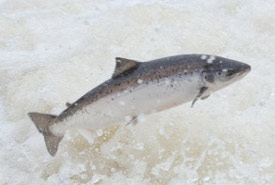Atlantic Salmon: Lake Ontario’s ghost fish

Atlantic salmon jumping in Humber River (Photo by Tom Moffatt/ASF)
The Atlantic salmon is usually associated with Canada’s east coast, where declining populations of the species have inspired conservation efforts by the Nature Conservancy of Canada, as well as Fisheries and Oceans Canada.
Historically, Lake Ontario held the world’s greatest freshwater population of Atlantic salmon, before the species vanished from the lake in the late 19th century. Today, the Atlantic salmon is a Great Lakes ghost and the target of restoration efforts aiming to bring it back to Lake Ontario.
Atlantic salmon arrived in Lake Ontario 12,000 years ago at the end of the last Ice Age, when great sheets of ice receded and connected open fresh water to the ocean via a patchwork of streams and rivers.
For millennia, Atlantic salmon provided food for Aboriginal peoples. The earliest European settlers to Ontario relied on it for sustenance. Some settlers reputedly established homesteads on the sale of salmon alone. By the 1800s, catches of Atlantic salmon were so extensive that diarist Elizabeth Simcoe (wife of the first Lieutenant Governor of Upper Canada) remarked that people caught and sold these salmon by the barrel-full.

Illustration by the New York Dept. of Environmental Conservation
Like all Salmonidae, Atlantic salmon are anadromous, meaning they spend most of their life at sea but return to fresh water to spawn. Occasionally, however, salmon become trapped in lakes and adapt to living in fresh water full-time. Such was the case in Lake Ontario, where Atlantic salmon relied on the lake’s connecting freshwater streams to lay their eggs.
The Atlantic salmon’s life cycle occurs in stages. Adults migrate to tributaries in the fall, where females dig redds (nests) in the gravely bottoms and deposit up to 8,000 eggs. Males then fertilize the eggs, which hatch after 100 days. The hatchings, called alevin, feed on their yolk sacs for up to three months before they begin foraging on their own as fry.

Illustration by North Atlantic Salmon Conservation Organization
After three to six months, the fry enter the parr stage (juveniles over a year old with prominent bars on their sides) and remain in the stream for the next few years. When the parr are old enough to swim into Lake Ontario, they transition to the smolt phase and remain in the lake until they mature into adults and return to the streams to spawn.
These stream-reliant spawning habits played a major role in Atlantic salmon’s extirpation (local extinction) from Lake Ontario. As southern Ontario grew in the 19th century, trees were felled to make way for farmland, resulting in erosion and an increase in water temperatures that left the salmon’s streams too warm and too clouded. The need to power the region’s bustling cities also spurred the construction of dams in nearly all of Lake Ontario’s tributaries, blocking the salmon from reaching their spawning sites. Overfishing and pollution also contributed to a decrease in the Atlantic salmon population.
By 1898, the fish had officially vanished from the lake.
During the 20th century, Atlantic salmon remained the ghost that used to swim Lake Ontario. In the 1940s, the Canadian Department of Lands and Forests attempted to stock the lake using fish from Miramichi, New Brunswick, but this effort failed due to high water temperatures and predation. The 1960s saw sporadic attempts at restocking that also fell short.
In 1987, the Ministry of Natural Resources (MNR) launched a research effort into habitat viability, genetic variables and stocking methods, with the goal of establishing a self-sustaining population of Atlantic salmon in at least one of Lake Ontario’s tributaries. This effort saw only modest success, but it did inspire MNR to invest in a larger recovery strategy.
In 1995, MNR began stocking up to 200 fry per year for eight years. These stocking efforts proved promising, and paved the way for the 2006 launch of the Lake Ontario Atlantic Salmon Restoration Program. Also known as Bring Back the Salmon, the restoration program is a joint effort between MNR, the Ontario Federation of Anglers and Hunters and a host of other public, non-profit and private partners.
The program’s components include sustained stocking efforts, habitat restoration/protection, recovery research/monitoring and education and outreach. Structured in five-year phases, in 2011 the program stocked more than 2.5 million salmon into three Lake Ontario tributaries: Credit River, Duffins Creek and Cobourg Brook. Phase II added salmon raising at Fleming College. Phase III launched in spring 2016.
The program is anticipated to take 10-15 more years to re-establish a self-sustaining population of Atlantic salmon in Lake Ontario. Stocking efforts have begun to reap rewards, as Atlantic salmon are now spawning in the Credit River after a 150-year absence.
Beyond the restoration efforts in Lake Ontario, the Nature Conservancy of Canada (NCC) has protected 436 acres (176 hectares) in the Salmonier River area to date. The Salmonier River is a popular salmon river with healthy numbers of the threatened south Newfoundland population of wild Atlantic salmon. NCC is also protecting headwater streams on the Oak Ridges Moraine in Northumberland County, with tributaries that feed into existing or potential salmon streams.
These continued efforts to restore the Atlantic salmon to Lake Ontario and beyond may bring this heretofore ghost fish back to life in Canadian waters.


